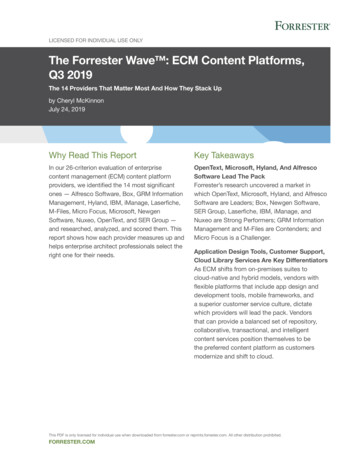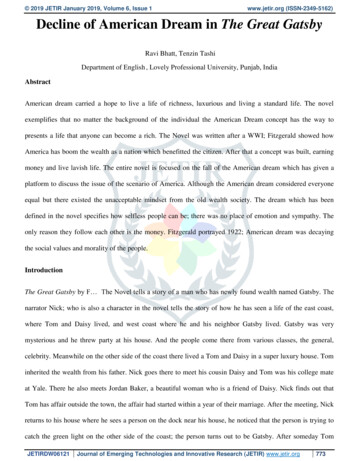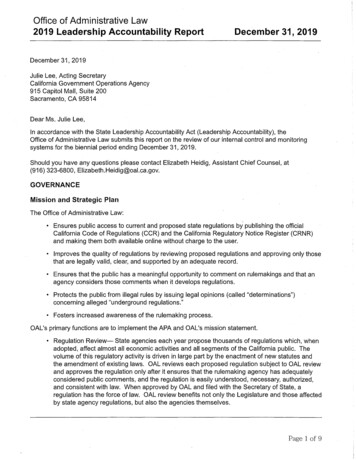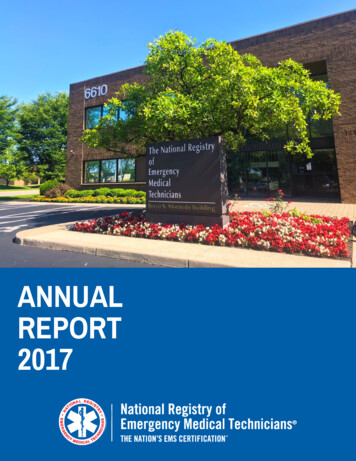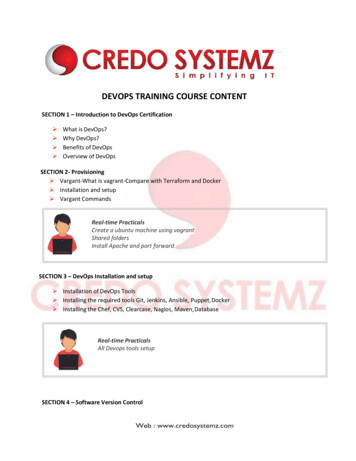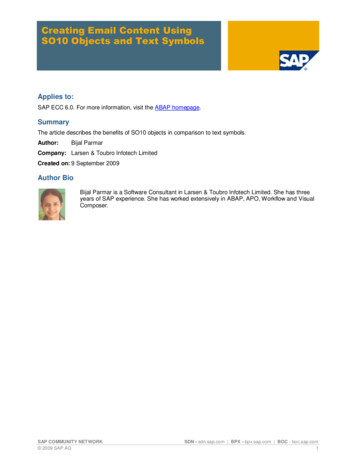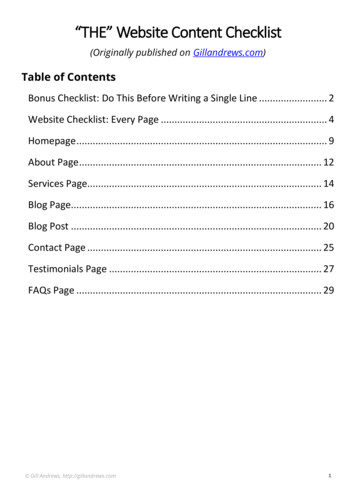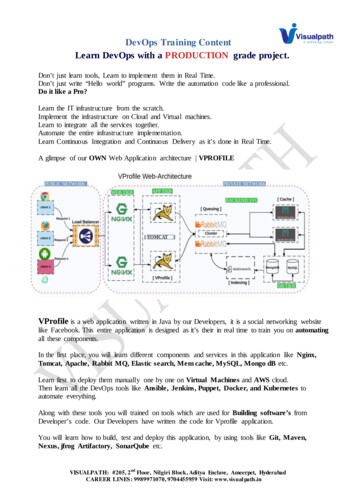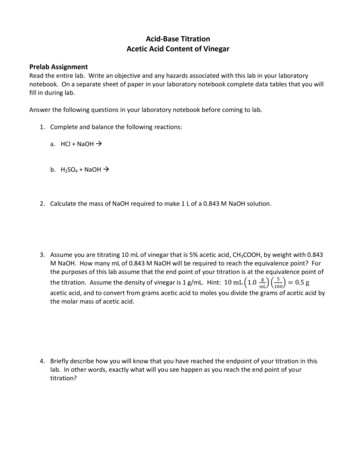
Transcription
Neuendorf, K. A. (2019). Content analysis and thematic analysis. In P.Brough (Ed.), Research methods for applied psychologists: Design,analysis and reporting (pp. 211-223). New York: Routledge.
Advanced Research Methodsfor Applied PsychologyDesign, Analysis and ReportingEdited byPaula Brough15031-2022d-1pass-r03.indd 36/16/2018 7:54:23 AM
First published 2019by Routledge2 Park Square, Milton Park, Abingdon, Oxon OX14 4RNand by Routledge711 Third Avenue, New York, NY 10017Routledge is an imprint of the Taylor & Francis Group, an informa business 2019 selection and editorial matter, Paula Brough individual chapters, thecontributorsThe right of Paula Brough to be identified as the author of the editorialmaterial, and of the authors for their individual chapters, has been assertedin accordance with sections 77 and 78 of the Copyright, Designs andPatents Act 1988.All rights reserved. No part of this book may be reprinted or reproduced orutilised in any form or by any electronic, mechanical, or other means, nowknown or hereafter invented, including photocopying and recording, or inany information storage or retrieval system, without permission in writingfrom the publishers.Trademark notice: Product or corporate names may be trademarks orregistered trademarks, and are used only for identification and explanationwithout intent to infringe.British Library Cataloguing-in-Publication DataA catalogue record for this book is available from the British LibraryLibrary of Congress Cataloging-in-Publication DataA catalog record has been requested for this bookISBN: 978-1-138-69889-5 (hbk)ISBN: 978-1-138-69890-1 (pbk)ISBN: 978-1-315-51797-1 (ebk)Typeset in Bemboby Apex CoVantage, LLC15031-2022d-1pass-r03.indd 46/16/2018 7:54:23 AM
18 Content analysis andthematic analysisKimberly A. NeuendorfIntroducing content analysis and thematic analysisMessage analysesContent analysis and thematic analysis are two prominent methods used forthe analysis of message content. Both have been defined in various ways andhave been applied to a wide range of phenomena. This chapter will focus onkey definitions and applications useful for those involved in applied psychologyresearch.The two methods have similarities – both involve codes and coding (Ahuvia,2001), that is, a process of representing message content with abbreviated, convenient symbols. These codes may be applied to messages by human investigators (coders) or, in the case of some content analyses, by computer programsthat use predefined search algorithms. The messages to be coded may be (a) analready-existing set of messages, such as postings to the “Men’s Room” bulletinboard of an online fertility support group (Malik & Coulson, 2008), “fitspiration” images posted on Instagram (Tiggemann & Zaccardo, 2016), or popularpornographic videos (coded for aggressive and sexual behaviors; Bridges et al.,2010); or, these messages may be (b) messages newly created by research participants, such as open-ended questionnaire responses in surveys and experiments,interview responses, dream analysis reports, focus group transcripts, transcriptsof customer service interactions, or responses within such personality assessment strategies as Rorschach testing and thematic apperception tests (TAT)(Weiner & Greene, 2017). Clearly, for the latter class of messages (b), there willbe important considerations that precede the application of content analysis orthematic analysis – i.e., the research design and protocol including the questionsparticipants are asked or procedures executed on them and an appropriate planfor the selection of participants.Both methods also may attempt to tap both manifest (i.e., directly observable variables) and latent (i.e., unobservable constructs) content (Joffe & Yardley,2004). Both methods should be applied only after research questions or hypotheses have been forwarded, in order to appropriately guide the analysis. And, asJoffe and Yardley (2004) note, both methods are taxing and time consuming.15031-2022d-1pass-r03.indd 2116/16/2018 7:55:11 AM
212 Kimberly A. NeuendorfThere are no shortcuts to a properly conducted, painstaking investigation ofmessages using either thematic analysis or content analysis.But the two methods also have important differences. Historically, contentanalysis has followed a paradigm of positivism, with chiefly quantitative techniques used, dating to the early twentieth century (Berelson, 1952; Neuendorf, 2002; Smith, 2000). More recent variations have introduced “qualitativecontent analysis” (Altheide & Schneider, 2013; Mayring, 2014; Schreier, 2012;Vaismoradi, Turunen, & Bondas, 2013), which actually has many characteristicsin common with other qualitative analyses of messages, including thematicanalysis. Thematic analysis, an addition to the options for message analysis inpsychology in the 1970s, developed from within a more constructivist paradigm (although some argue that it is positivist in its requirement that assertions ought to be supported with evidence) and an emphasis on an interpretiveapproach to largely qualitative techniques1 (Guest, MacQueen, & Namey, 2012;Merton, 1975).Thematic analysis assumes that the recorded messages themselves (i.e., thetexts) are the data, and codes are developed by the investigator during closeexamination of the texts as salient themes emerge inductively from the texts.These codes most often consist of words or short phrases that symbolicallyassign an “essence-capturing, and/or evocative attribute” (Saldaña, 2016, p. 4)and are viewed interactively, to be modified throughout the coding process bythe investigator. While the investigator may begin the thematic analysis process with “templates” (a set of a priori codes), the epistemological roots of thetechnique dictate that these codes need to be flexible, able to be modified asthe analysis progresses (King, 2004). The conclusion of the thematic analysisis the identification of a (hopefully) saturated set of themes (i.e., no additionalthemes are found from additional data; Ando, Cousins, & Young, 2014) and ameaningful “codebook” or other compilation of findings that documents thestructure of codes and themes, with the validity of the findings paramount.Thefrequency of occurrence of specific codes or themes is usually not a main goalof the analysis.Content analysis (in its most common, quantitative form) assumes that themessages (texts) are the phenomena to be examined and provide the unitsof data collection – the data are the recorded occurrences of specified codesas applied to these units. Codes are developed a priori in a primarily deductive process and then applied in relatively objective fashion by trained coderswhose intercoder reliability is viewed as critical, or via an automated computerassisted coding process. The codes are most often numeric, usually representing categories of a nominal variable, but may alternatively represent levels of ametric variable. The conclusion of the typical content analysis is the statisticalsummarization and analysis of the coded variables across many units of analysis.It should be noted that the a priori coding scheme of a content analysis hasoften been developed at least in part through a process very much like thematicanalysis – an inductive step of deriving salient variables and their codes from thepool of message content to be studied. This is particularly true of investigations15031-2022d-1pass-r03.indd 2126/16/2018 7:55:11 AM
Content analysis and thematic analysis213in which scant existing theory or past research guides the content analyst in thedevelopment of a coding scheme. And in all instances, investigator “immersion”in the message content being studied is recommended as a first step for boththematic analysis and content analysis (Clarke & Braun, 2014; Neuendorf, 2017).Thematic analysisDefining thematic analysisThematic analysis has been defined broadly as “a way of seeing” and “makingsense out of seemingly unrelated material” (Boyatzis, 1998, p. 4). Braun andClarke (2006) identify it as a method for identifying and analyzing patternsof meaning in a dataset (i.e., texts).2 The process is seen as organic and reflexive, requiring an “engaged, intuitive” investigator who considers “the ways inwhich they are part of the analysis. . . [making] TA a personal, and sometimeseven emotional, experience” (Braun, Clarke, & Terry, 2015, p. 107). The goalis to develop a story from the texts of interest. The investigator notes patternsand themes from the coded texts and from this may construct a codebook, astructured compendium of codes that includes a description of how codesinterrelate (Guest et al., 2012, p. 50). Coding categories often form a hierarchy of categories (Joffe & Yardley, 2004). The end result of a thematic analysiswill highlight the most salient “constellations” of meanings present in the texts(Joffe, 2012).Themes may be presented in a map, indicating processes or hierarchy among the themes (Braun, Clarke, & Terry, 2015).The typical process of thematic analysisClarke and Braun (2014; see also Braun & Clarke, 2006, and Braun, Clarke, &Rance, 2015, pp. 188–189) present a recursive six-phase process for thematicanalysis:123456Familiarising oneself with the data (text; may be transcriptions) and identifying items of potential interestGenerating initial codes that identify important features of the data relevantto answering the research question(s); applying codes to the dataset (segmenting and “tagging”) consistently; collating codes across segments of thedatasetSearching for themes; examining the codes and collated data to identifybroader patterns of meaningReviewing themes; applying the potential themes to the dataset to determine if they tell a convincing story that answers the research question(s);themes may be refined, split, combined, or discardedDefining and naming themes; developing a detailed analysis of each themeProducing a report; weaving together the analytic narrative and data segments, relating the analysis to extant literature15031-2022d-1pass-r03.indd 2136/16/2018 7:55:11 AM
214 Kimberly A. NeuendorfBoyatzis’ widely cited volume (1998) provides a comprehensive treatmentof the process of developing codes and the full process of thematic analysis.Altheide and Schneider (2013) outline the process of developing themes andframes for the analysis of media content. And Saldaña (2016) provides a detailedguide of the “how to” of coding for qualitative analysis.In addition to the development of codes and the identification of themes,other analytic techniques may assist in constructing the story of the data (Guestet al., 2012), such as word searches and key-word-in-context (KWIC) output.For this, computer adjuncts are employed, called QDAS (qualitative data analysis software) or CAQDAS (computer-assisted qualitative data analysis). Programs such as NVivo 11, Atlas.ti, and QDA Miner provide organizing powerand give basic quantitative summaries as well (see Joffe & Yardley, 2004). Thetypical QDAS functions include the facilitation of the creation of a codebookwith definitions and examples, the application by the investigator of codes,comments, and memos to text (“text” may also include images and multimediacontent), the retrieval of content segments that have been coded, and visualrepresentations of co-occurrence relationships among codes (e.g., via networkconcept mapping, dendrograms, or cluster analysis).While interrater/intercoder reliability is not routinely assessed in thematicanalyses, some scholars argue that this ought to be part of the process (Boyatzis,1998; Joffe & Yardley, 2004). And some investigators have indeed included aconsideration of reliability by employing additional analysts for comparativepurposes (e.g., Chambers et al., 2013).Examples of thematic analysisExamples of thematic analyses show the range of message content that may beexamined and the types of findings that are typical. In all cases, themes are anoutcome, and these themes may be further subdivided or combined in a hierarchical or process-based model.Tierney and Fox (2010) sought to discover the perspective of individualswho have lived with an “anorexic voice.” Twenty-two participants from threeUK self-help organizations participated, providing accounts in the form ofpoems, letters, and reflections/descriptive narratives. Initial analyses produced135 codes, which were grouped into 10 categories, such as “attacking sense ofself,” “demanding and harsh task master,” and “breaking free.” Further, threestages of the “voice” were identified in a model of change from positive tonegative: “being drawn into the relationship”; “ensnared in the relationship”;and “life without the relationship.”In a study of online support groups of individuals with Parkinson’s disease,Attard and Coulson (2012) studied a random sample of postings in four discussion forums over the years 2003–2010. The 1,013 messages in the samplerevealed six major themes and 16 subthemes. For example, the theme “Welcome to the land of the Parky people” included the subthemes of “comfortin numbers,” “empathy and understanding,” and “friendship formation”; the15031-2022d-1pass-r03.indd 2146/16/2018 7:55:11 AM
Content analysis and thematic analysis215theme “It’s like a graveyard at the moment,” included the subthemes of “lack ofreplies,” “symptom restrictions,” and “a lack of personal information.”Open-ended written responses to the query “How would you define sexualsatisfaction?” were the focus of a thematic analysis by Pascoal, Narciso, andPereira (2014). They developed a three-level hierarchical thematic map fromcodes derived from responses generated by 760 heterosexual participants. Theirmain themes (at the highest, or third, level) were “personal sexual well-being”and “dyadic processes,” with the latter divided into three subthemes (at the second level) and five codes (at the first level).Content analysisDefining content analysisA brief definition of content analysis has been proposed by this author: “Thesystematic, objective, quantitative analysis of message characteristics” (Neuendorf, 2017, p. 1).3 Content analysis may be applied to any message content.Analyses may be as complex as for any other quantitative study, including predictive regression analyses and structural equation models (e.g., Neuendorfet al., 2010; Sultan & Wong, 2011)Human-coded content analysis vs. CATAContent analysis may be executed by human coding according to a predefined coding scheme or by computer program using a predefined set of searchdictionaries and algorithms (often termed computer-aided text analysis, orCATA). For all types of quantitative content analysis, the construction of an apriori coding scheme is important. Examples of coding schemes may be foundat the Content Analysis Guidebook Online (http://academic.csuohio.edu/neuendorf ka/content/; Neuendorf, 2017).The typical process of content analysisAs delineated in Neuendorf (2017), the typical steps in the execution of a content analysis are:12345Theory and rationaleConceptualizations – identification of variables to be included in the study andconceptual definitions of them derived from theory, past research, and possibleemergent variables from an inductive examination of the message contentOperationalizations (measures) – should match the variables’ conceptualizationsEstablishment of coding scheme – either a codebook and coding form (forhuman coding) or a set of original or predefined dictionaries (for CATA)Sampling – deciding on the population of messages to be studied and sampling an (optimally) representative subset of messages for the study15031-2022d-1pass-r03.indd 2156/16/2018 7:55:11 AM
216 Kimberly A. Neuendorf6789Coder training and pilot intercoder reliability assessmentCodingFinal intercoder reliability assessmentTabulation and reportingPsychometric content analysisOf particular interest to psychologists has been the application of content analysis to psychometrics, the quantitative measurement of psychological characteristics. While self-report inventories are perhaps the most common methodof psychometric assessment, a second main way is via performance-basedmeasures (Weiner & Greene, 2017). The latter includes assessment via Rorschach testing, thematic apperception tests (TAT), figure-drawing methods, andsentence completion methods. The scoring of the output of these techniquesmatches the process of quantitative content analysis – i.e., raters/coders aretrained on a coding scheme, and their interrater reliability is assessed (Jenkins,2017; Weiner & Greene, 2017).Smith et al. (1992; see also Smith, 2000) presents a large volume of predefined coding schemes for the nonclinical measurement of psychological characteristics called thematic content analysis. The volume began with a focus onthe needs of scholars coding TAT outcomes but was expanded to include coding open-ended survey responses, archival historical documents, and everydayverbal materials such as conversations, reports of dreams, and transcripts of TVprograms. Coding schemes include power motivation, intimacy motive, andpsychological stances toward the environment, among many others. Contentanalysis has also been used to assess psychometrics for clinical purposes, as withthe coding scheme developed by Gottschalk and colleagues. The CATA formof this scheme, PCAD, is described in the next section.CATA optionsThere are dozens of available computer-aided text analysis (CATA) programs(see Neuendorf, 2017, for a fuller list and comparison chart). Some of the moreuseful CATA programs that show the range of options are:PCAD (Psychiatric Content Analysis and Diagnosis)The application of content analysis to an individual’s naturally occurring communication (e.g., speech or writing) in order to assess mental states, emotions,and neuropsychiatric indicators to provide preliminary diagnostics for psychiatric purposes was the life’s work of Louis Gottschalk. With his team, he firstdeveloped an elaborate human-coded scheme, with a computer-driven system(PCAD) the eventual outcome (Gottschalk, 1995; Gottschalk & Bechtel, 2007;2008). The 40 PCAD measures include 14 subscales for depression, cognitive15031-2022d-1pass-r03.indd 2166/16/2018 7:55:12 AM
Content analysis and thematic analysis217impairment, and six anxiety subscales. Unlike most other content analyses (andthematic analyses), PCAD is designed for idiographic purposes.4 That is, the 40measures are applied to an individual in order to produce “candidate diagnosesfor consideration” for that individual. For example, President Ronald Reaganwas found to exhibit a “significant increase” in cognitive impairment betweenthe 1980 and 1984 presidential debates (although Gottschalk held the release ofthe findings until 1987; Romney, 1997).LIWC2015 (Linguistic Inquiry and Word Count)Devised as an automated method to detect important differences among essaysby individuals who had undergone traumatic experiences, LIWC has sincebeen used in a wide array of other applications (Pennebaker, 2011; Pennebaker et al., 2015). LIWC uses dozens of dictionaries to measure linguisticand paralinguistic dimensions, relativity dimensions, psychological constructs(e.g., affective processes, such as anger; cognitive processes, such as inhibition),and other constructs. Pennebaker and Chung (2009) applied LIWC to textsauthored by al-Qaeda leaders Osama bin Laden and Ayman al-Zawahiri, comparing their speech with that of other extremist groups, concluding that binLaden increased his cognitive complexity and emotionality after 9/11 and thatpost-2003 the use of anger and hostility words by both al-Qaeda leaders wasmuch higher than that for other extremist groups.Profiler PlusProfiler Plus is a “general purpose text analytics (natural language processing)system” that allows for multi-pass, rule-based analyses of text, relying on substantial researcher input and specification rather than machine learning (socialscience.net/tech/profilerplus.aspx). The platform offers a number of codingschemes that have already been created for applied projects, such as LeadershipTrait Analysis and conceptual/integrative complexity. A number of Profiler Pluscoding schemes are computerized adaptations of psychometric measures presented in the Smith et al. (1992) volume, including need for achievement, needfor affiliation, and need for power. User-created, custom coding schemes mayalso be devised.YoshikoderThe freeware Yoshikoder is particularly useful for analysts who are constructing their own CATA dictionaries.Yoshikoder performs basic functions, such asword counts, dictionary term counts/data, KWIC, and concordances, making ita good vehicle via which to learn the typical process and principal functions ofCATA.The program provides options for the use of both predefined dictionaries and custom dictionaries pass-r03.indd 2176/16/2018 7:55:12 AM
218 Kimberly A. NeuendorfAdditional examples of content analysesAdditional examples of content analyses show the range of message contentthat may be examined and the types of findings that are typical. Both humancoded and CATA examples show how predefined coding schemes and CATAdictionaries are employed to produce quantitative data for analysis.Tiggemann and Zaccardo (2016) conducted a human-coded content analysis of 600 images on Instagram marked with the “fitspiration” hashtag. Their apriori coding scheme included measures of body type, activity, objectification,and inspirational and dysfunctional quotes. Intercoder reliability was acceptablefor each of the 11 measured variables. Results included the finding that mostimages of women represented only one body type – thin (75.2%) and visiblytoned (56.2%). Further, a majority of images were found to include objectifyingelements (56%).Responses to semi-structured interviews were the content analyzed in Stahland Caligiuri’s (2005) study of coping strategies employed by expatriate managers while on international assignment. Interviews were conducted with 116German managers in Japan or the U.S. A coding scheme comprised of 30 different variables (i.e., types of coping strategies) was developed via a combination of inspection of past literature and emergent codes from an examination ofthe interview transcripts. All variables in the coding scheme were found to haveacceptable intercoder reliability. The most frequently reported coping strategieswere “emphasizes the positive in a difficult situation,” “tries to control the situation by taking initiative,” and “intentionally violates cultural norms.” The 30strategies were further divided into two types: problem-focused (k 14) andemotion-focused (k 16). Combining these data with additional self-reportsurvey data from the 166 managers, the investigators found that the predictionof cross-cultural adjustment from the use of problem-focused coping strategieswas moderated by cultural distance and position level.Bligh, Kohles, and Meindl (2004) examined how elements of the speeches ofPresident George W. Bush changed in response to the post-9/11 environment.The CATA program DICTION (www.dictionsoftware.com/; Hart, 2014),which was designed to examine the linguistic characteristics of political speech,was applied to 74 speeches collected from the official White House website(n 39 pre-9/11 and n 35 post-9/11). Six of the 31 predefined dictionarybased measures in DICTION were the focus. In ANCOVA statistical analyses,it was found that the post 9/11 speeches were significantly more likely toincorporate references to collectives, faith, patriotism, and aggression and lesslikely to reference ambivalence (after controlling for speech length and wordvariety). There was no pre/post difference found for the measure of optimism.Blended approachesThematic analysis and content analysis each has its own set of characteristics thatmight be viewed as advantages, and each has limitations (see Braun & Clarke,15031-2022d-1pass-r03.indd 2186/16/2018 7:55:12 AM
Content analysis and thematic analysis2192013). Thematic analysis produces a depth of understanding of the meaning ofa set of texts.The investigator is the instrument, and reliability among investigators is not typically assessed.5 For content analysis, a main assumption is that acoding scheme is independent of the individual perspective of an investigator.The instrument is not the investigator but rather the coding scheme, whichis not adaptable during the final coding process. Reliability between coders isparamount.Increasingly, scholars have called for mixed-methods research, integratingqualitative and quantitative approaches in a single study (Guest et al., 2012),as well as the triangulation of methods across studies. A purposeful pairing ofqualitative and quantitative analyses has obvious advantages, given the complementary goals of each (Gray & Densten, 1998; Hardy, Harley, & Phillips, 2004).Some scholars have recognized this complementarity. Fereday and MuirCochrane (2006) called for a hybrid approach to thematic analysis, includingboth deductive and inductive coding.Walker, van Jaarsveld, and Skarlicki (2017)utilized a mixed-method approach to analyzing customer service employeeincivility toward customers. Brough, O’Driscoll, and Biggs (2009) provide anexample of a hybrid approach to content analysis and thematic analysis in whichan initial, a priori content analysis coding scheme based on theoretic and practical considerations was supplemented by additional codes derived in an iterative, emergent process of thematic analysis. The analysis examined responses tosemi-structured interviews with parents who had returned to work within ayear of the birth of a child. The resulting scheme was assessed for reliability bythe inclusion of an additional coder. The study exemplified the viability of ablended approach to message analysis.ConclusionThe utility of message analysis techniques, including the oft-used content analysis and thematic analysis, has been demonstrated in hundreds of studies acrossdisciplines, including applied psychology. These two sets of methods producedifferent types of conclusions, with content analysis providing quantitative,objective, reliable measures about messages and thematic analysis most typicallyresulting in qualitative, inductive, conclusions about themes in message content.The two types may be seen as complementary, each providing a different perspective on a set of messages. As the volume of recorded messages continues togrow, notably online, applications of these two message analysis techniques willbecome increasingly important.Notes1 The distinction between quantitative and qualitative might be viewed as “a rather thinand discreet line. . . [as] most qualitative studies do contain some kind of quantitativeinformation (numbers)” (Schedler & Mudde, 2010, pp. 418–419). Elsewhere, I recommend applying the labels of quantitative and qualitative separately to the phenomenon15031-2022d-1pass-r03.indd 2196/16/2018 7:55:12 AM
220 Kimberly A. Neuendorfunder investigation and to the analytical strategies used to describe or summarize the phenomenon. For example, the typical task of quantitative measurement is to assign numericalvalues to qualities of a phenomenon (Neuendorf, 2017).2 Beyond thematic analysis, other examples of wholly qualitative methods include phenomenological analysis, grounded theory, hermeneutic analysis, narrative analysis, discourseanalysis, and conversation analysis (see Alhojailan, 2012; Harper & Thompson, 2012;Rohleder & Lyons, 2015; Smith, J. A., 2008). Thematic analysis is reported to be compatible with the overarching methodologies of various qualitative research approaches (e.g.,phenomenology).3 The more detailed definition given in my textbook on content analysis follows:Content analysis is a summarizing, quantitative analysis of messages that follows thestandards of the scientific method (including attention to objectivity – intersubjectivity, a priori design, reliability, validity, generalizability, replicability, and hypothesistesting based on theory) and is not limited as to the types of variables that may bemeasured or the context in which the messages are created or presented.(Neuendorf, 2017, p. 17)4 However, some investigators have used the PCAD measures on multiple cases for nomothetic purposes (for the distinction between idiographic and nomothetic approaches, seeTe’eni, 1998, and Weiner & Green, 2017). For example, Smith (Smith, S. S., 2008) appliedmeasures from PCAD, as well as from Profiler Plus, to 96 instances of threatening communication from FBI case files. Among other findings, she reported that threateners exhibiting less ambivalent hostility (from PCAD) and higher conceptual complexity (fromProfiler Plus) were more likely to act on their threat.5 Some scholars have proposed processes of reliability and validity assessment in thematicanalysis by the inclusion of additional, independent reviewers to validate themes and toindicate level of reliability of feedback across reviewers (Alhojailan, 2012). However, thesetechniques, more closely aligned with positivist perspectives, are not routinely part ofthematic analysis.ReferencesAhuvia, A. (2001). Traditional, interpretive, and reception based content analyses: Improvingthe ability of content analysis to address issues of pragmatic and theoretical concern. SocialIndicators Research, 54, 139–172.Alhojailan, M. I. (2012). Thematic analysis: A critical review of its process and evaluation.West East Journal of Social Sciences, 1(1), 39–47.Altheide, D. L., & Schneider, C. J. (2013). Qualitative media analysis (2nd ed.).Thousand Oaks,CA: Sage.Ando, H., Cousins, R., & Young, C. (2014). Achieving saturation in thematic analysis: Development and refinement of a codebook. Comprehensive Psychology, 3, Article 4.Attard, A., & Coulson, N. S. (2012). A thematic analysis of patient communication in Parkinson’s dise
5 Defi ning and naming themes; developing a detailed analysis of each theme 6 Producing a report; weaving together the analytic narrative and data seg-ments, relating the analysis to extant liter
